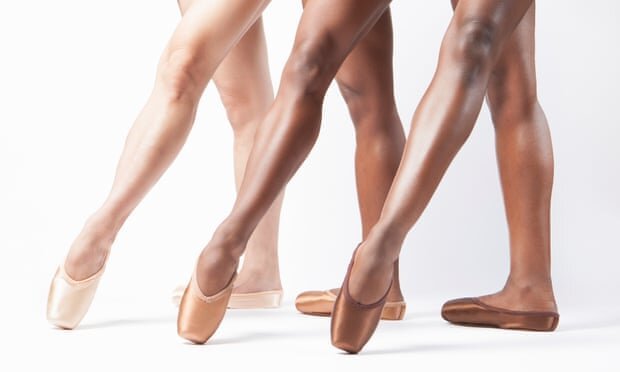Ballet in the 21st Century: Flesh Tone for All!
Pointe shoes by Freed of London. Photo credit: Tyrone Singleton.
[ Image description: Three dancers are framed from the knee down. They are posed side by side with one leg extended in a crossed forward diagonal. The dancers wear pointe shoes that match their flesh tones: the dancer on the left a light flesh tone, in the middle a tan flesh tone, and on the right a cocoa brown flesh tone. ]
Ballet pink, classical pink, European pink. This is the range of tones I grew up with in my dancewear experience. It’s no wonder I knew no color other than pink for the greater part of my dance training; I took pink for granted as the unquestionable uniform of classical ballet. I, however, am not pink.
It wasn’t until my late teens that I saw--and a few years later danced for--Dance Theatre of Harlem that I was introduced to the concept of flesh tone ballet attire. DTH pioneered the use of flesh tone tights and shoes in classical ballet. This revelation changed me deeply, and though I remained tied to the ballet world outside of DTH, I struggled physically and emotionally to engage with pink after finding and loving my flesh tone. I hid pangs of pain, apprehension, and shame each time I was called upon to return to pink, most often when performing classical ballets. I hesitated to wear pink in class and rehearsal; I couldn’t look at myself in the mirror like that, but on stage I didn’t have to. On stage I could just be someone else. I had to be someone else.
But what if I didn’t have to be someone else? This is the question facing ballet companies and dancewear makers as they reckon with deep-seated racial inequities in the context of shifting global demographics and cultural attitudes. It is only in the past few years that flesh tone ranges for ballet tights and shoes have expanded beyond pink and a single monolithic “nude” based on a median European flesh tone. Even with the advent of a widening range of colors dubbed bronze, suntan, cocoa, and espresso, access is woefully inequitable, often limited to special orders, and true custom color-matching remains out of reach. Representation and implementation of flesh tone garments in schools, training programs, and classical ballet repertory remain low.
What would it mean to provide a budding brown dancer with the tools they need to feel like themselves in an art form they love, to see themselves represented on stage, in the studio, and in their local dancewear store? What would it mean to the parents of young, impressionable dancers entering into an artistic practice that has historically excluded them for something they can’t change? What would it mean to potential audiences? What would it mean just to have a choice beyond pink, beyond one neutral Eurocentric “nude”? The answer to all these questions is that it means more than we can ever know, and the only way to find out is to do it: the ballet industry must put flesh tone forward on stage, in studios, and in the dancewear market now. We must normalize this vision in order to effect meaningful change and begin to undertake a real revolution of values. It might be strange for a while, but soon we will never be able to look back.
I can gratefully acknowledge that change is beginning to manifest, but there is so much left to do. The ballet establishment must do this work earnestly and with full commitment framed by the desire to advance the values of our deeply human art form into the current global reality. Ultimately this is about far more than dancewear; it’s about racial equity, representation, visibility, and access.
Flesh tone tights and shoes are the tangible manifestations of a much deeper cultural and aesthetic shift in the field of classical ballet. I felt that shift in the moment of awe when the curtain rose on Dance Theatre of Harlem. I felt it in the tireless dedication each night I stayed up late sponge painting pink satin to bronze so I could put on my pointe shoes the next morning. I still feel it every time I see a ballerina fully glowing in her skin--especially the little ones. If we keep pushing, they’ll be the ones lucky enough to know a world where ballet pink, classical pink, and European pink are not their only options.
Find flesh tone dancewear through these Black-owned online retailers:
Global brands offering wider arrays of flesh tone shoes and apparel:
